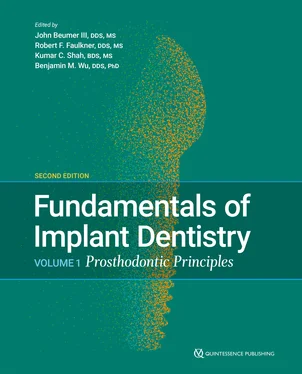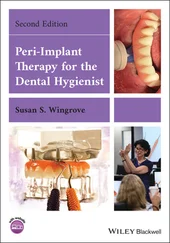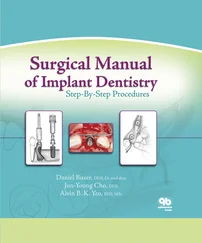After initial tightening, loss of preload can occur due to material deformation such as creep, wear, corrosion, and other mechanisms that alter the fit between the screw and the threads. Preload relaxation can result in screw loosening and fracture and is more likely when the initial surface rough spots on the screw-thread interface initiate contact and subsequently undergo wear and/or deformation over time. This is expected in most bolt joint assembly and is consistent with studies reporting loosening torque values that are usually 80% to 90% of tightening torque. 26These studies are based on delivering a normal range of recommended torque values, and when excessive tightening torques are used, phenomena such as cold welding and galling occur that may increase the removal torque. Excessive tightening torque can occur if the torque drivers are not calibrated or are used improperly. In these simple mechanical joint configurations, the screw compresses the separate components together and by itself offers minimal resistance to shear, tensile, torsion, and bending deformations. Without additional joint design features to add resistance, micromotion leads to component wear. Galling is a common adhesive wear and transfer of material between contacting metallic surfaces, causing them to seize together, but can be reduced by application of lubricants. In order to better appreciate screw mechanics, it is useful to understand some physical concepts relating to contact between surfaces. When contact is achieved between two metallic surfaces, the initial interaction is between high points found on the surfaces, such as the screw thread tips, known as the asperities . When movement is applied, the surface irregularities penetrate the opposing surface, causing friction and/or plastic deformation, and pressure is induced, which increases heat and adhesion. Deformation of the contacting surfaces is known as settling , and when components are pressed together, microsurface irregularities on the component surfaces, screw head, and screw threads are flattened out. The magnitude of settling that occurs is a direct function of the initial surface roughness, surface hardness, and the magnitude of loading force applied. Rougher surfaces and larger loads are associated with greater settling. This “settling” effect also occurs when the strength and stability of the implant-abutment connections are inadequate, and more stresses are transmitted to the screw. This is one of several reasons that nonsplinted external hex connections tend to have more screw loosening than internal connections (hex, octagon, conical, Morse taper, etc). Fortunately, preload relaxation can be reversed by retightening the screws over time. To counter the effects of settling clinically, it is recommended that screws are initially torqued down, with further torque applied after waiting 10 minutes once settling has occurred. 27Many textbooks still teach the practice of retightening 1 week after initial tightening because as more settling occurs, less friction is available because of cyclic loading and wear. New screws are recommended after multiple tightening and loosening cycles.
To stabilize the joints, antitipping and antirotational features are incorporated into both internal and external implant connection designs to provide resistance to joint-separating forces. The original Brånemark implants have an external hexagonal connection, but the minimal height of the hexagon limits the extent of stability achievable. This has been addressed with the Brånemark Mk III and Mk IV implants (Nobel Biocare) by increasing the hexagonal wall height to between 0.7 mm (narrow and regular platform) and 1.0 mm (wide platform). Other implant systems with an external hexagon connection include Biomet 3i (Osseotite and Naontite External Hex Implant System), Southern Implants (External Hex Implants), and Straumann (Narrow Neck). Alternatively, a variety of internal connections have been developed with tapered or conical designs are available from Straumann, Bicon, Astra Tech, Southern Implants, and ITS Implants, and internal connections are available in hexagon (Certain 6-point, Zimmer Biomet), double hexagon (Certain 12-point, Zimmer Biomet; Astra Tech Implant System, Dentsply), or trilobe (Nobel Biocare Tri-Lobe; Southern Implants Tri-Lobe). Antirotational features are particularly important for single-implant restorations where engaging abutments with interlocking features are used, as opposed to nonengaging abutments for multi-unit applications. The internal indexing design with seven-point configuration would engage the implant and ensure specific orientation of the individual custom abutment. While this is beneficial for single-tooth restorations, these features may complicate multiple-unit implant restorations with divergent implant angulations.
The properties of screw materials determine both the optimal preload as well as the ability to maintain preload under cyclic loading. Materials used for implant screws include gold alloy, titanium, gold-plated gold-palladium titanium alloy (Gold-Tite, Zimmer Biomet), and polytetrafluorethylene (PTFE)-coated titanium (TorqTite, Nobel Biocare). Titanium is prone to galling and settling. The friction between titanium and other metals is initially low, but with repeated tightening following loosening, it increases to about that of titanium against titanium. However, all screw materials are susceptible to screw loosening. Coating screw surfaces with pure gold creates a very smooth surface, reducing settling effects. Gold alloy screws are capable of greater preload than titanium screws. Dry lubricant coatings reduce friction, allowing greater preloads to be achieved. A recent study reported that saliva contamination reduces reverse torque on implant screws, but blood and fluoride contamination had no effects. 28Interestingly, the same study showed that chlorhexidine contamination actually increased the reverse torque values above statistical significance. It should be noted that previous studies did not report a saliva effect. 26
Gold-coated screws (Gold-Tite) have very smooth surfaces due to a thin coating of pure gold, while in contrast, PTFE-coated screws (TorqTite) have rougher surfaces. With repeated loosening and retightening, delamination of the PTFE-coated surface has been observed, so it is recommended that TorqTite PTFE-coated screws should be replaced rather than reused and retightened repeatedly. Historically, to ensure screws remained tightly clamped, some implant manufacturers recommended wrapping PTFE tape around the threads (Integral System, Calcitek) or applying a bonding agent to the threads (Ceka Bond, Preat). With current screw materials and surfaces, these precautions are not generally needed. Generally speaking, due to galling and settling effects affecting thread shape, repeatedly loosened screws should be replaced to ensure optimal preloads are attained and to avoid the risk of screw fracture associated with increased friction when torque is applied.
The most effective way to prevent screw loosening is to ensure that they are tightened sufficiently at the time of placement. The maximum torque generated by hand is approximately 15 to 25 Ncm, 29– 31and torque wrenches are necessary to obtain optimal tightening torques beyond this. It is debatable whether to tighten screws to the point where they are difficult to loosen; this depends upon the type of prosthesis used to restore the patient. For example, implant-assisted implant connecting bars retaining overdentures are subject to wear and may need to be removed and remade 15 to 20 years following initial placement. Individual attachments retaining overdentures also wear and need periodic replacement; therefore, the screws retaining these devices must be removable. Screw loosening is less of an issue to manage for screw- retained prostheses, whereas for cement-retained prostheses where retrieveability is difficult, it is much more important to prevent screw loosening. Use of torque wrenches is therefore more critical for cement-retained prostheses. However, torque wrenches are consistently inaccurate 32– 34and must be recalibrated on a regular basis. Even with calibrated torque wrenches, parameters such as friction that determine K torquewould affect the actual preload achieved.
Читать дальше












